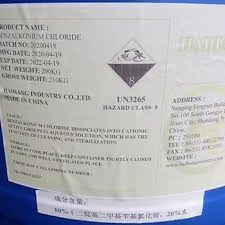coagulants and flocculants
Coagulants and Flocculants Key Agents in Water Treatment
Water treatment is an essential process that ensures the delivery of safe and clean water for various uses, including drinking, agriculture, and industrial applications. Among the myriad of approaches used in water treatment, the use of coagulants and flocculants plays a pivotal role in the efficient removal of sediments, impurities, and contaminants from water sources. Understanding the functions and applications of these agents is crucial for optimizing water treatment processes.
What are Coagulants?
Coagulants are chemical substances used to promote the agglomeration of suspended particles in water. When added to water, coagulants destabilize the colloidal particles by neutralizing their charges, which causes them to clump together, forming larger particles known as flocs. This process is known as coagulation, and it is essential for removing contaminants such as dirt, clay, organic matter, and microorganisms.
Common coagulants used in water treatment include aluminum sulfate (alum), ferric chloride, and polyaluminum chloride. These substances are favored for their effectiveness in a wide range of pH levels and their ability to perform well in various water qualities. The choice of coagulant often depends on the specific characteristics of the water being treated, such as its turbidity and pH.
What are Flocculants?
Flocculants are agents that aid in the aggregation of the flocs formed during the coagulation process. They help to bind these larger particles together, making them heavier and easier to remove through sedimentation or filtration. While coagulants initiate the coagulation process, flocculants enhance it by fostering the formation of larger aggregates, which settle faster and can be easily separated from the treated water.
Typically, flocculants are high molecular weight polymers that can be anionic, cationic, or non-ionic, depending on their charge and composition. The selection of a suitable flocculant is critical as it must be compatible with the coagulant used and efficient in the specific water matrix.
The Coagulation and Flocculation Process
The coagulation and flocculation process generally involves several steps
coagulants and flocculants

1. Rapid Mixing The coagulant is rapidly mixed with the water to ensure uniform distribution and immediate interaction with suspended particles. 2. Floc Formation Following rapid mixing, the water undergoes slow mixing, allowing the neutralized particles to collide and form larger flocs.
3. Flocculation In this phase, flocculants are added, enhancing the aggregation of flocs and promoting the formation of even larger particles.
4. Sedimentation Once adequate floc formation is achieved, the mixture is allowed to sit undisturbed, permitting the heavier flocs to settle at the bottom.
5. Filtration The clarified water is then filtered to remove any remaining particles and flocs, resulting in clean water.
Applications in Water Treatment
Coagulants and flocculants find extensive applications across various sectors, including municipal water treatment, wastewater management, and even industrial processes such as paper production, mining, and oil extraction. In municipal water treatment, these agents are vital for maintaining water clarity and safety by removing pathogens and harmful substances.
In wastewater management, coagulants and flocculants contribute to the reduction of solid waste and pollutants, ensuring compliance with environmental regulations before the discharge of treated effluents.
Conclusion
Coagulants and flocculants are indispensable tools in the realm of water treatment. By efficiently removing suspended particles and improving water clarity, they play a critical role in safeguarding public health and the environment. As water scarcity and pollution challenges continue to rise globally, the optimization of coagulation and flocculation processes will be vital in ensuring a sustainable and safe water supply for future generations. Understanding the science behind these agents not only enhances treatment efficiency but also contributes to the ongoing quest for innovative solutions in water management.
-
lk-319-special-scale-and-corrosion-inhibitor-for-steel-plants-advanced-solutions-for-industrial-water-systemsNewsAug.22,2025
-
flocculant-water-treatment-essential-chemical-solutions-for-purification-processesNewsAug.22,2025
-
isothiazolinones-versatile-microbial-control-agents-for-industrial-and-consumer-applicationsNewsAug.22,2025
-
scale-inhibitor-key-solutions-for-water-system-scale-preventionNewsAug.22,2025
-
organophosphonates-versatile-scale-inhibitors-for-industrial-water-systemsNewsAug.22,2025
-
scale-and-corrosion-inhibitor-essential-chemical-solutions-for-water-system-maintenanceNewsAug.22,2025





